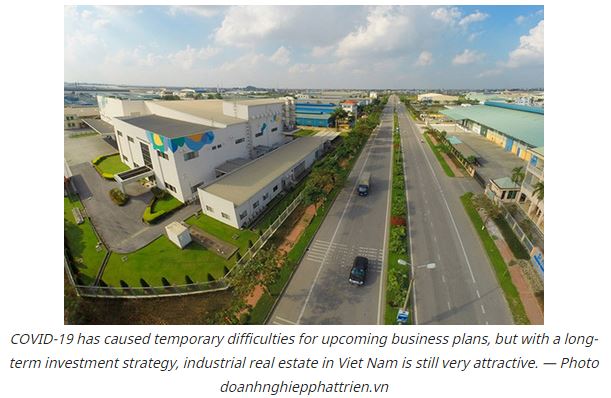Vietnam emerges as popular industrial property destination: CBRE
Vietnam has emerged as a popular destination for industrial property projects as increased labour costs, trade disputes and COVID-19 prompt global manufacturers to vary their supply chains throughout Asia, according to CBRE.
The US-China trade conflict benefited Viet Nam’s industrial property market in 2019 as manufacturers began shifting production to alternative markets.
Average asking rents for industrial land in Viet Nam increased by as much as 10 per cent, with some industrial parks reporting rent growth of up to 40 per cent year-on-year, CBRE said.
Vietnam Jones Lang Lasalle Company (JLL Vietnam) said land prices in the industrial property segment have reached new levels even though the disease has impacted the land lease process.
COVID-19 has caused temporary difficulties for upcoming business plans, but with a long-term investment strategy, industrial real estate in Viet Nam is still very attractive.
In the second quarter of this year, JLL Vietnam recorded rising land prices with an average of US$106 per sq.m for a lease cycle, up 9.7 per cent compared to the same period last year for the southern industrial property market.
Meanwhile, the rent price of ready-built factories was still stable at $3.5-5 per sq.m per month, because the contract is only short term for 3-5 years and tenants are also susceptible to the pandemic’s impact.
The recent disruptions have prompted companies to diversify supply chains throughout Asia.
“We have seen some manufacturers moving away from centralised supply toward increased diversification,” said Desmond Sim, head of research, Singapore and Southeast Asia, at CBRE. “Countries that are already investing in new infrastructure and are more open to attracting industry likely will receive the lion’s share of relocations.”
“CBRE also expects to see a shift in trade patterns with this growing focus on diversifying supply chains and production locations,” Sim said.
This trend has already started. While China is the world’s largest export economy by value, China-to-US exports decreased by 12.7 per cent in 2019, and total trade between the countries fell by US$100 billion year-on-year.
Countries that have benefited from this shift include Taiwan and Viet Nam, the fastest-growing trade partners with the US. Total trade between the US and these two markets rose in 2019 by $18.7 billion and $9.1 billion, respectively. Countries outside Asia, such as Belgium, the Netherlands and France, have seen increased activity as well.
Although there are some barriers to entry, including a shortage of industrial land in prime locations and a lack of infrastructure in key areas, Viet Nam’s manufacturing industry and industrial real estate market stand to benefit from the rapid changes in global trade and supply chains, as long as trade with developed countries remains a key growth driver, according to CBRE.
In addition to infrastructure facilitating the movement of goods and driving demand for logistics space over the long term, CBRE also sees e-commerce growth changing warehousing demand in Asia-Pacific, including Viet Nam.
Total cross-border e-commerce sales in the region are expected to more than double to $389.5 billion in 2023 from $181.4 billion in 2018.
The integration of local supply chains likely will blend industrial and retail real estate, affecting the way goods are warehoused and delivered to consumers.
Bonded warehouses, which enable storage of goods without payment of duty, are increasingly popular amid rising consumer demand for imported products, as they facilitate faster delivery than direct shipping from the country of origin.
CBRE expects an increase in leasing demand for these warehouses, especially in large consumer markets such as China and India. — VNS
Source: https://vietnamnet.vn/en/business/vietnam-emerges-as-popular-industrial-property-destination-cbre-662869.html


 Thailand
Thailand




